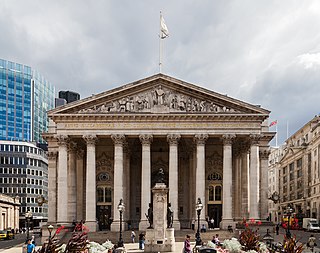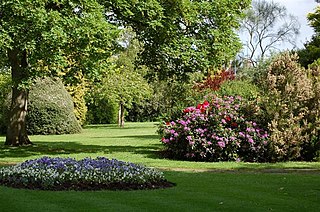
Leicester Square is a pedestrianised square in the West End of London, England. It was laid out in 1670 as Leicester Fields, which was named after the recently built Leicester House, itself named after Robert Sidney, 2nd Earl of Leicester. The square was originally a gentrified residential area, with tenants including Frederick, Prince of Wales and the artists William Hogarth and Joshua Reynolds. It became more down-market in the late 18th century as Leicester House was demolished and retail developments took place, becoming a centre for entertainment. Major theatres were built in the 19th century, which were converted to cinemas towards the middle of the next. Leicester Square is the location of nationally significant cinemas such as the Odeon Luxe Leicester Square and Empire, Leicester Square, which are often used for film premieres. The nearby Prince Charles Cinema is known for its screenings of cult films and marathon film runs. The square remains a tourist attraction which hosts events, including for the Chinese New Year.

Threadneedle Street is a street in the City of London, England, between Bishopsgate at its northeast end and Bank junction in the southwest. It is one of nine streets that converge at Bank. It lies in the ward of Cornhill.

Berkeley Square is a garden square in the West End of London. It is one of the best known of the many squares in London, located in Mayfair in the City of Westminster. It was laid out in the mid 18th century by the architect William Kent, and originally extended further south. The garden's very large London Plane trees are among the oldest in central London, planted in 1789.

The Royal Exchange in London was founded in the 16th century by the merchant Sir Thomas Gresham on the suggestion of his factor Richard Clough to act as a centre of commerce for the City of London. The site was provided by the City of London Corporation and the Worshipful Company of Mercers, who still jointly own the freehold. The original foundation was ceremonially opened by Queen Elizabeth I who granted it its "royal" title. The current neoclassical building has a trapezoidal floor plan and is flanked by Cornhill and Threadneedle Street, which converge at Bank junction in the heart of the city. It lies in the Ward of Cornhill.

Sir Henry Cole FRSA was an English civil servant and inventor who facilitated many innovations in commerce and education in the 19th century in the United Kingdom. Cole is credited with devising the concept of sending greetings cards at Christmas time, introducing the world's first commercial Christmas card in 1843.
A covenant, in its most general sense and historical sense, is a solemn promise to engage in or refrain from a specified action. Under historical English common law, a covenant was distinguished from an ordinary contract by the presence of a seal. Because the presence of a seal indicated an unusual solemnity in the promises made in a covenant, the common law would enforce a covenant even in the absence of consideration. In United States contract law, an implied covenant of good faith is presumed.

Coventry Street is a short street in the West End of London, connecting Piccadilly Circus to Leicester Square. Part of the street is a section of the A4, a major road through London. It is named after the politician Henry Coventry, secretary of state to Charles II.
John Birnie Philip was a nineteenth-century English sculptor. Much of his work was carried out for the architect Sir George Gilbert Scott.

Musgrave Lewthwaite Watson was an English sculptor of the early 19th century.

Wyld's Great Globe was an attraction situated in London's Leicester Square between 1851 and 1862, constructed by James Wyld (1812–1887), a distinguished mapmaker and former Member of Parliament for Bodmin.

Essex County Council is the county council that governs the non-metropolitan county of Essex in England. It has 75 councillors, elected from 70 divisions, and has been under Conservative majority control since 2001. The council meets at County Hall in the centre of Chelmsford. It is a member of the East of England Local Government Association.
Lewis Vulliamy was an English architect descended from the Vulliamy family of clockmakers.

The Clock Tower is a free-standing clock tower in the centre of Brighton, part of the English city of Brighton and Hove. Built in 1888 in commemoration of the Golden Jubilee of Queen Victoria, the distinctive structure included innovative structural features and became a landmark in the popular and fashionable seaside resort. The city's residents "retain a nostalgic affection" for it, even though opinion is sharply divided as to the tower's architectural merit. English Heritage has listed the clock tower at Grade II for its architectural and historical importance.

Park Crescent is a mid-19th-century residential development in the Round Hill area of Brighton, part of the English city of Brighton and Hove. The horseshoe-shaped, three-part terrace of 48 houses was designed and built by one of Brighton's most important architects, Amon Henry Wilds; by the time work started in 1849 he had 35 years' experience in the town. Wilds used the Italianate style rather than his more common Regency motifs. Three houses were replaced after the Second World War because of bomb damage, and another was the scene of one of Brighton's notorious "trunk murders" of the 1930s. The three parts of the terrace, which encircle a private garden formerly a pleasure ground and cricket pitch, have been listed at Grade II* by English Heritage for their architectural and historical importance.

Tulk v Moxhay is a landmark English land law case which decided that in certain cases a restrictive covenant can "run with the land" in equity. It is the reason that Leicester Square exists today.
Charles Augustus Tulk (1786–1849) was an English Swedenborgian and politician.

Henry Musgrave, DL, was an Irish businessman and philanthropist.

Samuel Noble (1779–1853) was an English engraver, and minister of the New Church (Swedenborgian).

Thurston's Hall was a major billiards and snooker venue between 1901 and 1955 in Leicester Square, London. The hall was in the premises of Thurston & Co. Ltd which relocated to Leicester Square in 1901. The building was bombed in 1940 and reopened under a new name, Leicester Square Hall, and new management in 1947. The venue closed in 1955 and the building was demolished to make way for an extension to Fanum House. The Hall was used for many important billiards and snooker matches, including 12 World Snooker Championship finals between 1930 and 1953. It was also the venue of the first World Snooker Championship match in November 1926. The hall was sometimes referred to as "Thurston's Grand Hall". There was also a "Minor Hall" in the same building.



















